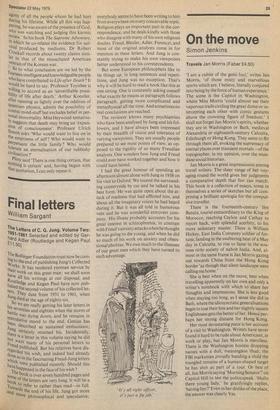Final letters
William Sargant The Letters of C. G. Jung. Volume Two: 1951.1961 Selected and edited by Gerhard Adler (Routledge and Kegan Paul £11.50) The Bollinger Foundation must now be coming to the end of publishing Jung's Collected Works. It has rendered yeoman service by their work on this great man: we shall soon have all his writings at our disposal, and R. outledge and Kegan Paul have now published the second volume of his collected letters' They date from 1951 to 1961, when Jung died at the age of eighty-six. h. '3° we are really getting his later letters in IS seventies and eighties when the storm of battle was dying down, and he remains in s. peculative mood to the end. Genius has 'pen described as sustained enthusiasm; tkung .eertainly, retained his. Incidentally, ,iere is a letter in this volume saying he did not t. -ant many of his personal letters to r eud Published. But his relatives have disrdegarded his wish, and indeed had already °n e in the fascinating Freud-Jung letters hieh were published recently. Should this ' nave ha some The book is over seven hundred pages and Cnle of the letters are very long. It will be a -rPek to refer to rather than read—in full, airvards the end of his life, Jung got more d more philosophical and speculative;
everybody seems to have been writing to him from everywhere on every conceivable topic. Religion plays an important part in the correspondence, and he deals kindly with those who disagree with many of his own religious doubts. Freud, Bleuler, Adler, Ferenczi, and 'most of the original analysts come in for mention in these letters. And Jung is constantly trying to make his own viewpoints better understood to his correspondents.
But some European philosophers like to tie things up, in long sentences and repetitions, and Jung was no exception. That's why it will be hard to read a book like this at one sitting. One is constantly asking oneself what exactly he means as paragraph follows paragraph, getting more complicated and metaphysical all the time. And sometimes no real conclusions are reached.
The reviewer knows many psychiatrists who have been analysed by Jung and his followers, and I have always been impressed by their breadth of vision and tolerance of varying viewpoints. They are usually people prepared to see most points of view, as opposed to the rigidity of so many Freudian analysts. One wonders how Jung and Freud could ever have worked together and how it could have lasted.
I had the great honour of spending an afternoon almost alone with Jung in 1938 on his visit to Oxford. We toured the surrounding countryside by car and he talked in his best form. He was quite open about the attack of madness that had afflicted him, and about all the imaginary voices he had heard during it. But it was all told in humorous vein and he was wonderful extrovert company. His illness probably accounts for his great interest in schizophrenia, in contrast with Freud'sanxiety attacks when he thought he was going to die young, and when he did so much of his work on anxiety and obsessional phobias. We owe much to the illnesses of our great men which they have turned to such advantage.


































 Previous page
Previous page